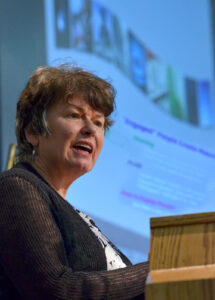Today’s Human Resources (HR) leader has a wonderful opportunity to make an important strategic contribution:
Become your organization’s Chief Culture Officer.
If your CEO already acts as the Chief Culture Officer, great. Then you can be his or her Chief Culture Execution Officer. But most CHROs aren’t that fortunate, and you may need some ammunition to persuade the CEO that focusing on building culture can be a source of competitive advantage:
- Researchers have found a “strong relationship between constructive organizational cultures and financial performance.” (Source: Eric Sanders and Robert Cooke, “Financial Returns from Organizational Culture Improvement: Translating ‘Soft’ Changes into ‘Hard’ Dollars,” Human Synergistics White Paper, 2011.)
- According to a Booz & Company report, “Culture matters, enormously. Studies have shown again and again that there may be no more critical source of business success or failure than a company’s culture–it trumps strategy and leadership (emphasis added).” (Source: Barry Jaruzelski, John Loehr, and Richard Holman, “The Global Innovation 1000: Why Culture Is Key,” Strategy + Business, Winter 2011.)
- Author James Heskett estimates that an “effective culture can account for 20 to 30 percent of the difference in performance versus ‘culturally unremarkable’ competitors.” (Source: Deidre Campbell, “What Great Companies Know About Culture,” Harvard Business Review Blogs, December 14, 2011.)
“I came to see, in my time at IBM, that culture isn’t just one aspect of the game, it is the game. In the end, an organization is nothing more than the collective capacity of its people to create value.” -Lou Gerstner, former IBM CEO
We think of organizational culture as “how we do things here”: how people behave. Culture forms over time and drives what happens when the bosses are not present. It sets the tone for the organization, the norms for what is acceptable behavior. Culture is a powerful force in determining how an organization operates and whether it succeeds.
Organizations with a toxic culture pay a heavy price in lost revenue, staff attrition, low productivity, damaged reputation, lawsuits, and more. Ego, greed, deceit, conflict, gamesmanship, mistrust, turf wars, backstabbing, and exploitation spawn toxic cultures.
Organizations with a nondescript, non-defined, haphazard culture (perhaps this sounds familiar?) do nothing to help their organizations compete and thrive.
By contrast, organizations with a high-performance culture of character—think of Southwest Airlines, Zappos, Patagonia, DreamWorks, Atlassian, Google, Warby Parker, REI, LinkedIn, Microsoft, Salesforce—set in motion a self-reinforcing, positive, and virtuous cycle with their stakeholders. Employees identify more with the enterprise and bring more of their talents, creativity, and commitment to their work. This healthy culture positively affects profitability, growth, productivity, staff retention, reputation, relationships with customers and suppliers, and more.
A healthy culture by no means guarantees success, but it provides the energy boost and commitment to build an exceptional organization. In a high-performance culture of character, everybody expects excellent, ethical, and enduring performance and impact—what we call “triple crown leadership.”
Culture is the legacy of leadership. A high-performance culture of character is the legacy of triple crown leadership.
So, what can Chief Human Resources Officers (CHROs) do to help their organizations excel? Here are some suggestions.
1. Become the Chief Culture Officer. Live and breathe culture-building, making it your top priority.
2. Persuade the CEO. Persuade your CEO that culture is critical. Volunteer to lead an effort to make your culture a competitive advantage. You probably don’t need more (or much more) money, time, or staff. You mostly need buy-in (and perhaps cover). Promise periodic updates on progress.
3. Align with Organizational Goals and Strategy. Make sure you have a seat at the goal- and strategy-setting meetings. Align your culture-building efforts to the goals and strategy. If you can’t gain that access immediately, ask another officer for a briefing.
4. Get a Baseline. Conduct a baseline assessment to determine what your current culture is. Your baseline can be as simple as gathering input on these questions: How do we do things here? What are the accepted norms of behavior? On a one-to-five scale, how does this culture contribute to or detract from the achievement of our goals and strategy? Use team meetings, employee interviews, online surveys, and/or town hall meetings to gather data. After a few weeks, you’ll have a good picture of the current culture.
5. Brainstorm and Synthesize the Ideal. Conduct a few sessions with some influential leaders at various levels in the organization. Explore questions like: What is our desired culture? How would we be operating if we were really the best-of-the-best in our field? From this input, you can synthesize a succinct and aspirational statement of your organization’s desired culture in a page or less.
6. Determine How to Fill the Gap. Now it’s time for some brainstorming and innovative thinking from you and your colleagues: “How do we fill the gap between the current culture and our desired culture? What must we do differently?” Be practical and specific. In the process, recruit committed volunteers and allies to begin the cultural transformation. Here are ideas for how to fill the gap:
- Make Culture a Priority. Keep the initiative visible. Get culture on daily agendas and priority lists across departments.
- Redefine Shared Purpose. Why does your organization exist? It’s likely not because of that vapid mission statement laced with jargon on your website and ignored in daily operations. See our guide for moving away from mission to inspirational purpose.
- Redefine Shared Values. Shared values are those things that are most important to you. Think about what you believe and stand for, and the norms for how people should behave. See our guide to setting organizational and team values.
- Hire and Promote for Cultural Fit. When you interview new talent, or are considering someone for a promotion, make his or her fit with your desired culture an explicit requirement. Write explicit culture requirements into job descriptions. Hire and promote slowly: in other words, only when you are confident of good cultural fit.
- Unleash Cultural Stewards. Though people all work in their functional areas (HR, IT, Sales, etc.), they should all have another job: steward of the culture. That means they have an irrevocable license to speak up, protecting and defending the desired culture and shared values—even speaking truth to power as a “voice of one.” These culture stewards can invoke peer pressure to change behavior.
- Inculcate Culture. Culture needs to be baked into the DNA of every team. Start with the groups or departments most likely to embrace the new culture ideas and methodically work your way toward those departments that are likely to resist. Culture change takes time, thoughtfulness, and discipline.
- Reward. Celebrate and reward people who are the cultural stewards though public recognition, awards, bonuses, raises, and promotions, as they do at Zappos and other companies. Be creative and resourceful, and have fun with this.
7. Culture Change Plan. Once you have identified your culture gap fillers, draft a Culture Change Plan. It doesn’t have to be long. Share it with all your colleagues as the road map for culture change.
8. Model It. As Chief Culture Officer, be the exemplar of the desired culture. Everyone will be watching what you do more than what you say. If (when) you slip up, admit it, apologize, and ask for help to improve.
9. Be Resolute. Use your leadership authority and position to insist that everyone operate by the cultural norms you set together. No exceptions, even for top performers. They too must operate by the shared cultural norms or leave. Otherwise, your efforts will be undermined. Our experience is that when toxic superstars depart for values violations, the aggregate performance level of the remaining group actually improves.
10. Appoint Culture Champions. Empower a small group of trusted colleagues across departments to be proactive about culture recommendations and to take independent action. Meet with them often and assess progress. Keep their enthusiasm levels high. You can’t do it all, and you need their leadership.
11. Conduct Periodic Assessments. Monitor the culture through periodic assessments, formal or informal. Culture change is not a one-shot fix. It is a never-ending process that needs time, attention, and leadership.
12.Brief the Leadership Team. Brief the leadership team, including the CEO and board members, quarterly (or even monthly) on what is happening with culture to achieve the corporate goals and strategy. Keep the initiative visible. Downplay your own role, and celebrate what leaders throughout the organization are doing to build the culture.
By creating a high-performance culture, you will engage people, build trust, infuse meaning into people’s work, bring more joy into your workplace, and position the organization for greatness.
Core Concept: Building, a high-performance culture of character is an unappreciated and underused way of helping organizations thrive. The CHRO should lead that effort.
-Bob and Gregg Vanourek
+++++++++++++++++++++++++
Bob and Gregg Vanourek, father and son, are co-authors of Triple Crown Leadership: Building Excellent, Ethical, and Enduring Organizations, a winner of the International Book Awards. Gregg Vanourek is a writer, teacher, speaker, and coach on personal and leadership development. He is co-author of three books, including LIFE Entrepreneurs: Ordinary People Creating Extraordinary Lives (a manifesto for integrating our life and work with purpose and passion) and Triple Crown Leadership (called “the best book on leadership since Good to Great“). Take Gregg’s Traps Test (Common Traps of Living), check out his Best Articles, get his newsletter, or watch his TEDx talk. If you found value in this article, please forward it to a friend. Every little bit helps!
















